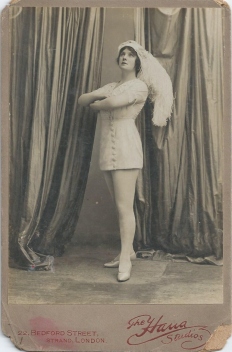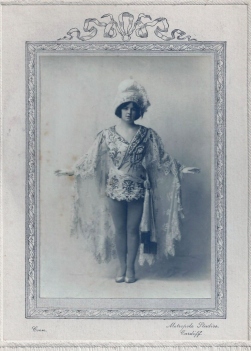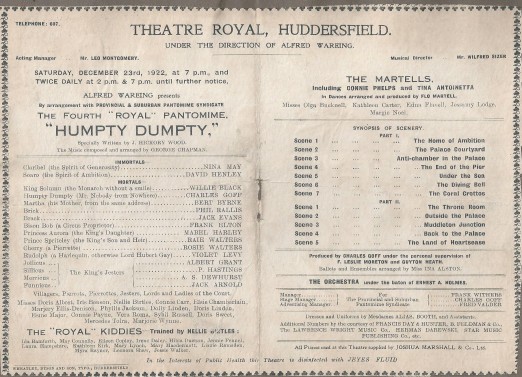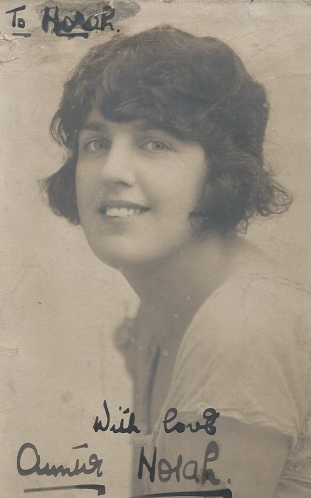When I started this blog, I thought I would write far more about my paternal great great aunt, Daisy Dormer. She was the biggest ‘star’ in the family history and information about her is easy to come by. Instead, I got carried away with uncovering the mystery of some of the less famous turns, and found their lives more satisfying to research. However, a research award from The Society for Theatre Research sent me back down the path of Daisy; to that end I found myself at the Bristol University Theatre Collection in the beautiful old Vandyck Building on Park Row. Almost opposite that building (now an unprepossessing petrol station with a Costa coffee outlet) there once was a theatre – the Prince’s, a beautiful Victorian treasure designed by well-known theatre architect, CJ Phipps in 1867. And there in December 1915, Daisy Dormer played the Principal Girl, Goody, in a production of the pantomime, Goody Two Shoes.
For those of my generation, mention Goody Two Shoes and the lyrics ‘Don’t drink, don’t smoke, what do you do?…’ spring to mind, along with an image of Adam Ant posing and gyrating in his New Romantic splendour. For another, older generation, Goody Two Shoes was a familiar pantomime. It is little performed these days but in the late Victorian and early Edwardian period it was a staple of the pantomime scene, based on the nursery tale published in 1765 by John Newbery. Goody Two Shoes is a variation of the Cinderella story. Virtuous Goody works hard to better herself and comes into money – either through marriage or a surprise inheritance – proof that her virtuousness has been rewarded.
The original tale was given a pantomime twist and all the usual panto characters incorporated into the ever-evolving plot-line – Dame, Fairy, Demon, wicked Duke, wealthy would-be lover, love-lorn yokels and comedy double-act. Goody in this Bristol re-telling (written by RC Oldham, a scenic artist trying his hand at writing) is the winsome daughter of the widowed and poverty-stricken Mrs Tutt – cue the Dame. Goody is in love with the orphaned, penniless village carpenter, Alan – ‘the cleverest man with his hands the village has got’. However, Clarence, the hapless son of the wicked Duke of Improvidentia has her in his sights. Mrs Tutt comes into money by magic and lo! and behold it turns out that Alan is the rightful heir to the Duke, having been stolen by fairies and another infant (Clarence) put in his place. All is well that ends well!
The production opened at the Prince’s on 23rd December 1915 and ran for 10 weeks, with the final performances on Saturday 4th March 1916. The Stage review declared it ‘one of the best productions that it has of late years been our pleasure to notice’.
At this point in her career, Daisy Dormer was well-established and had been playing Principal Girl in pantomime since the turn of the century. By the time she came to Bristol, she had played the role of Goody five times. In fact, she had been playing Goody for the past two pantomime seasons in this very production. Those previous productions had been a great success at the Grand Theatre, Leeds and the Theatre Royal, Manchester. The Manchester Courier had gone as far as describing the production ‘as near to the ideal pantomime as most of us are ever likely to see’ . The leading characters had all been played by the same troupe of performers, with the exception of the Principal Boy (played by a woman as per convention), who had been portrayed by both Daisy Wood (sister of Marie Lloyd) and Ella Retford in Leeds and Manchester respectively. In this production, ‘legitimate’ actress Sybil Arundale (veteran of Shakespeare and Ibsen) took the breeches and thigh-slapping honours:

- Sybil Arundale, courtesy of Margaret Monod (www.intothelimelight.org)
Horace Mills, a panto Dame veteran played the widowed Mrs Tutt. Sam Walsh and Doris Lind reprised their Duke and Duchess of Improvidentia roles. And Clarence, the hapless Duke’s son was portrayed for the third year running by 23 year old Lupino Lane. Lane was born into a long-standing family of theatricals and had been honing his dancing and ‘indiarubber’ acrobatic skills onstage since the age of four:
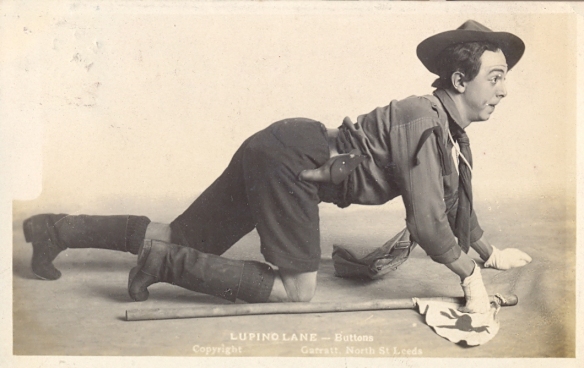
Lupino Lane, courtesy of the British Music Hall Society archive (www.britishmusichallsociety.com)
Goody Two Shoes had not been seen at the Prince’s before so the time was ripe for John Hart’s production to move lock, stock and barrel to Bristol with a few topical and local references and updated songs thrown in for good measure.
In an interesting juxtaposition, at the same time Daisy was appearing on stage in panto, a silent film she had made earlier that year for Vaudefilms, Potted Pantomimes (directed by WP Kellino), was on general release and being shown at Picture Houses throughout the country. Daisy wasn’t alone amongst the cast in trying their skills in this new world of moving pictures. Lupino Lane had made his first foray into film earlier that year and the script of Goody Two Shoes made frequent reference to this coming craze. When Daisy’s and Lupino’s characters first meet (in The Village of Blossomville, where else?):
Clarence: I say, this is a rotten hole! Why, you haven’t even a picture-house! How ever do you manage to exist?
Goody: A picture-house! What’s that?
Clarence: Never seen a picture-house? It’s where they have the moving pictures. Oh, I love them! – all cowboys and Red Indians, and burning houses, and dogs rescuing little girls from express trains. And there’s always a motor car, and then a lot of people chase it, and a detective finds out the man who looks like an actor has been lured to a big castle, with hundreds of rooms in it, by the Black Spot gang.
Goody: It must be very exciting.
Clarence: “Rather! I say”
In that exchange the future was set: the excitement and fascination with the moving image would eventually kill off their kind of live performance.
The craze was just beginning. In Bristol in December 1915, Picture Houses were on the rise providing stiff competition for live theatre. Advertising in the local press for December were the Zetland Picture House, Triangle Picture Hall, Coliseum Picture Theatre and the Cheltenham Road cinema. Clarence’s summary of moving pictures is nicely drawn: the fare on show in Bristol reflected that list: The Ticket of Leave Man, ‘the well-known drama of prison life’; The Swell Marksmen, ‘a drama of crime mystery and narrow escapes’; Human Hound’s Triumph, The Husband Who Showed Up and Lizzie Breaks into the Harem need no further tagline. Charlie Chaplin comedies were showing at the Coliseum Picture Theatre – Chaplin had signed a cinema contract in 1913, left his music hall days behind and was well on the way to becoming the greatest star on earth. Goody Two Shoes featured a popular hit song, ‘That Charlie Chaplin Walk,’ a foxtrot performed by Lupino Lane, with the chorus:
It doesn’t matter everywhere you go
Watch ’em coming out of any cinema show
Shuffling along, they’re acting like a rabbit
When you’ve seen Charlie Chaplin, you can’t help but get the habit
First they stumble over both their feet
Swing their sticks and look up and down the street
Fathers, mothers, sisters, brothers
All your wife’s relations and half a dozen others
In London, Paris and New York
Everybody does that Charlie Chaplin walk.
Lupino Lane’s imitation of Chaplin was described as ‘certainly by far the best that has been done in Bristol’. It is more than likely that the young Lupino Lane had been on the same stages as Chaplin in his earlier music hall days.
Moving pictures could be seen for as little as 3d (around £1.35 in today’s money) and often included a cup of tea, whereas panto tickets at the Prince’s started at 4d, with the best seats at 3s (around £16.50). From their introduction in the late 1890s, films had been regularly appearing on music hall bills as an end of evening novelty. Gradually they were moving into their own domain and providing a cheaper and what seemed a more innovative form of entertainment for the masses. The days of the music hall artiste were numbered.
Written with the support of a research award from the Society for Theatre Researchers – see here for details: www.str.org.uk

Notes
The Prince’s Theatre, Park Row, Bristol was originally called the Theatre Royal. Frank Matcham made alterations to the CJ Phipps design in 1884 and 1902, and a name change was made. It was destroyed during a bombing raid in 1940.
The John Hart/RC Oldham production lived another season – the following year it was back to the Grand Theatre Leeds, for the ‘revival’ show, with Daisy playing Goody once again with Lupino Lane and Horace Mills.
Lupino Lane continued life in pantomime, revue and film. He became a household name in the 1930s when he took the part of Bill Snibson first in Twenty to One (a musical farce) and then in the Noel Gay musical, Me and My Girl, which featured the catchy dance tune, ‘The Lambeth Walk’.



